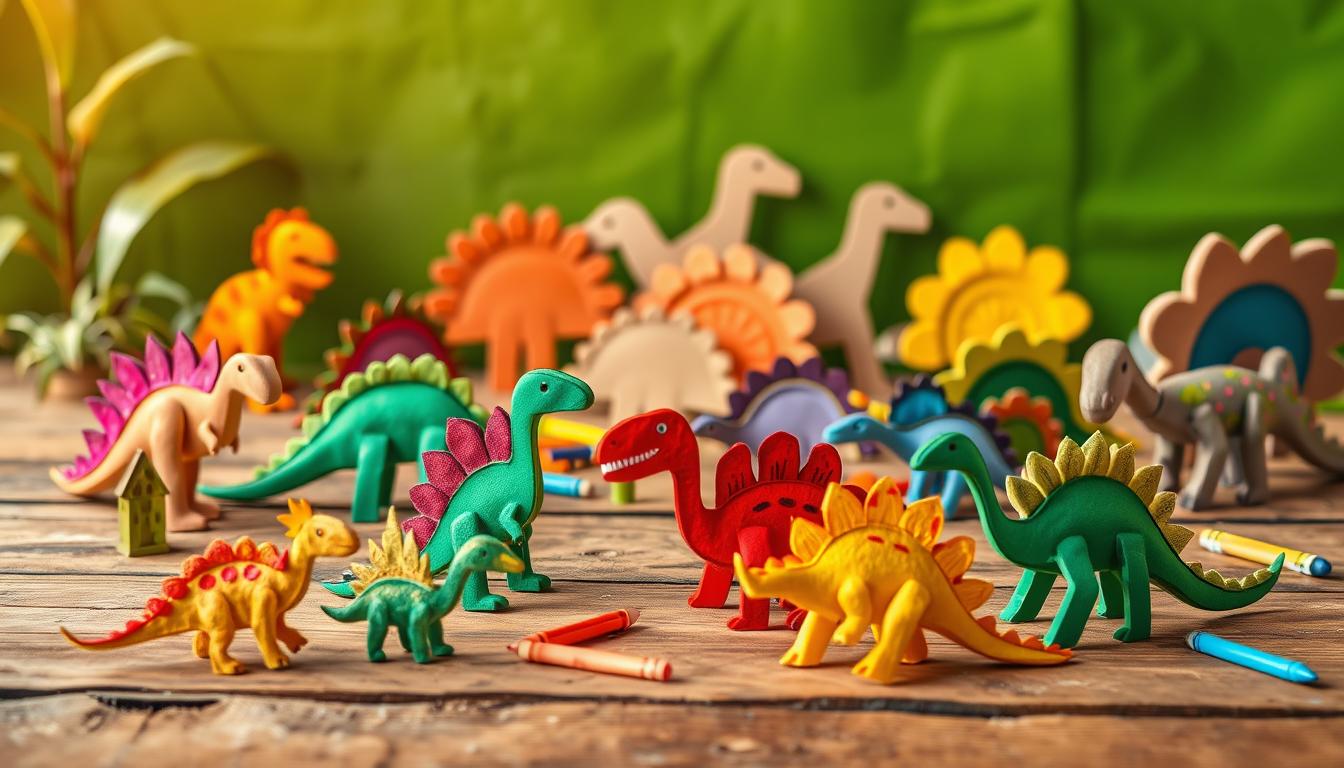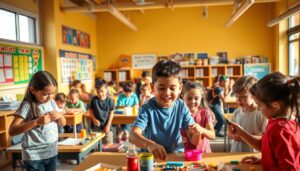Dinosaur Crafts and Learning Ideas
Last week, my neighbor Sarah texted me in a panic: “Help! My 4-year-old is obsessed with T-Rexes and keeps ‘digging’ holes in our backyard!” We brainstormed ideas until I suggested making paper plate dinosaurs together. Thirty minutes later, her kitchen table was covered in glue sticks, googly eyes, and the happiest little paleontologist you’ve ever seen.
That’s the magic of blending creativity with prehistoric wonder. This guide brings you 23+ hands-on projects that turn everyday items into Jurassic adventures. From squishy sensory bins to crunchy egg carton stegosauruses, every activity sparks curiosity while building skills like counting, color mixing, and fine motor coordination.
What makes these ideas special? They’re designed by parents and teachers who know short attention spans need quick wins. Most take 15-30 minutes – perfect for after-school energy bursts or rainy weekends. Best part? You’ll use supplies already hiding in your junk drawer.
Key Takeaways
- Engage young learners with projects matching their dinosaur obsession
- Develop skills through play: counting fossils, tracing dino footprints
- Budget-friendly ideas using household items like paper plates
- Flexible time options from quick activities to detailed creations
- Educational elements woven into every roaring adventure
Introduction to Dinosaur Crafts and Learning Ideas
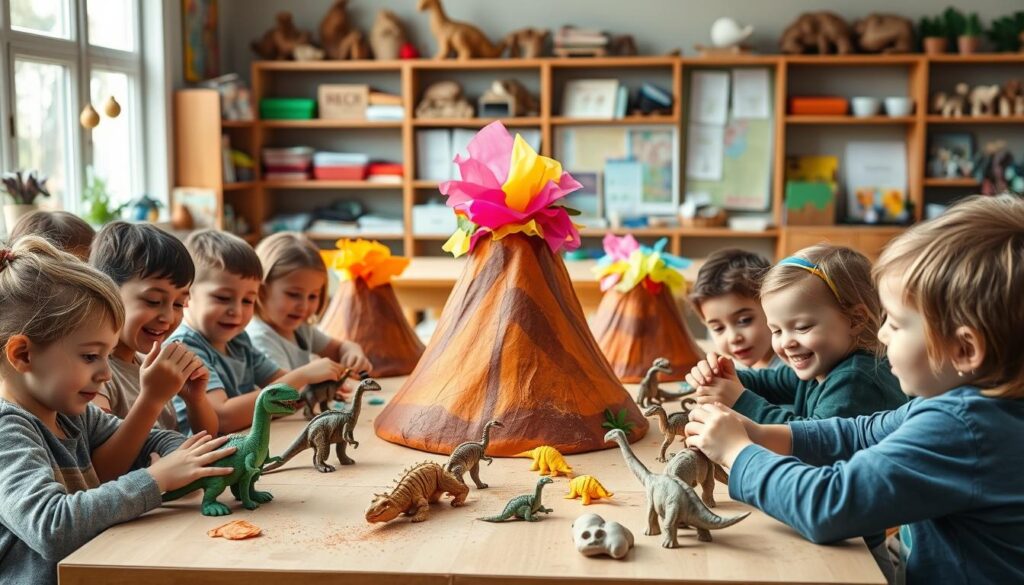
A teacher friend once transformed her classroom with papier-mâché volcanoes, watching kids erupt with curiosity about ancient Earth. “They started asking about lava viscosity before lunchtime,” she laughed. That’s the power of blending imagination with science.
Why Ancient Creatures Captivate Young Minds
Children crave mysteries bigger than their backyard. Prehistoric beings offer endless questions: “How did they move?” or “What color were their scales?” Hands-on activities let them become mini-scientists – measuring dino footprints with rulers or comparing tooth sizes using clay molds.
These projects bridge facts and fantasy. When creating a triceratops from egg cartons, kids explore texture and biology simultaneously. One parent noted: “My daughter corrected me about herbivore teeth – while gluing spinach leaves to her sculpture!”
Learning That Feels Like Play
Every cut-out shape strengthens finger muscles. Sorting button “fossils” by size teaches math concepts. Mixing paint for volcanic eruptions demonstrates color theory in action.
Teachers report improved attention spans during these fun challenges. “They don’t realize they’re practicing scissor safety,” says a preschool instructor. From counting spine plates to arranging timeline cards, skills grow alongside giggles and glue spills.
Essential Materials and Tools for Dinosaur Crafts
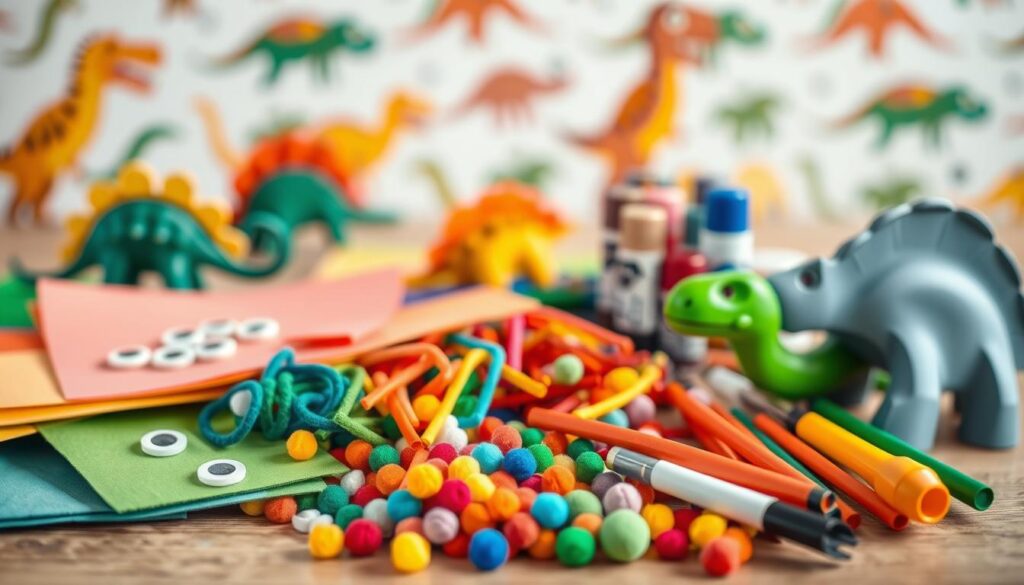
Transforming household trash into treasure isn’t magic—it’s just smart crafting. The best projects begin with items already cluttering your cabinets. A kindergarten teacher recently told me: “My students’ favorite T-Rex used an oatmeal container and leftover ribbon. They named him ‘Crunchy’!”
Everyday Items, Extraordinary Results
Paper products form the backbone of most activities. Construction paper becomes Jurassic landscapes. Toilet rolls transform into towering brachiosaurus necks. Even plastic cups turn into stamping tools for scale textures.
| Material Type | Common Uses | Cost Source |
|---|---|---|
| Paper plates | Dino bodies & masks | $1 store packs |
| Plastic bowls | Volcano bases | Recycled containers |
| Clothespins | Walking legs | Laundry room finds |
Basic tools matter most. Blunt scissors shape cardstock spikes safely. Droppers mix “volcanic” food coloring eruptions. Washable paints prevent permanent kitchen disasters.
One parent hack? “Store supplies in labeled jars – kids grab what they need without rummaging,” says mom-of-three Jessica Rivera. Dollar store bins keep pipe cleaners and googly eyes ready for spontaneous creations.
Creative Paper Plate Dinosaur Crafts
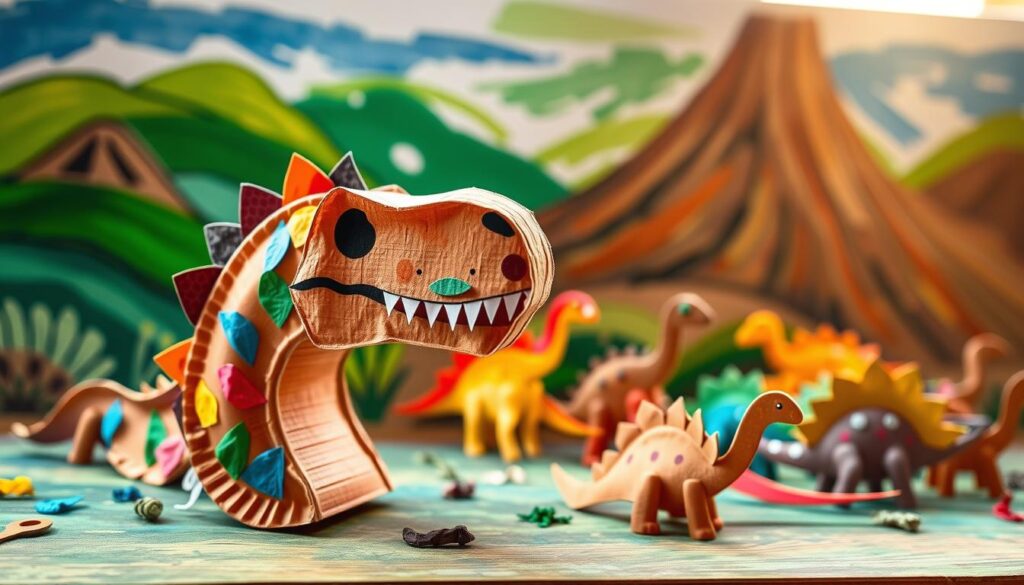
Rainy afternoons turn magical when paper plates become prehistoric pals. “Our kitchen looked like a mini museum after we made seven species!” laughs mom blogger Tina Chen. These projects transform basic supplies into movable masterpieces that teach through tactile play.
Start with three simple ingredients: paper plates, toilet paper tubes, and washable paint. Cut plates in half for curved bodies, then let young artists choose colors. Pro tip: Use toy dinos dipped in paint to stamp scale patterns before assembly.
| Dinosaur Type | Key Features | Materials Used |
|---|---|---|
| Stegosaurus | Bony plates | White cardstock triangles |
| Brachiosaurus | Long neck | Paper towel roll extension |
| T-Rex | Short arms | Red construction paper claws |
Attaching legs becomes a sneaky math lesson. Cutting slots in paper tubes helps kids visualize measurement. “We counted slots to match plate notches – now our dino walks!” explains 6-year-old Marco.
These creations spark extended learning adventures. Children compare neck lengths while building sauropods or debate herbivore diets when adding leafy decorations. Best part? Finished pieces double as puppets for Jurassic storytelling sessions.
Up next: Mold ancient fossils using kitchen ingredients! The fun continues as we explore salt dough impressions in section 5.
Engaging Dinosaur Fossil Crafts Using Salt Dough
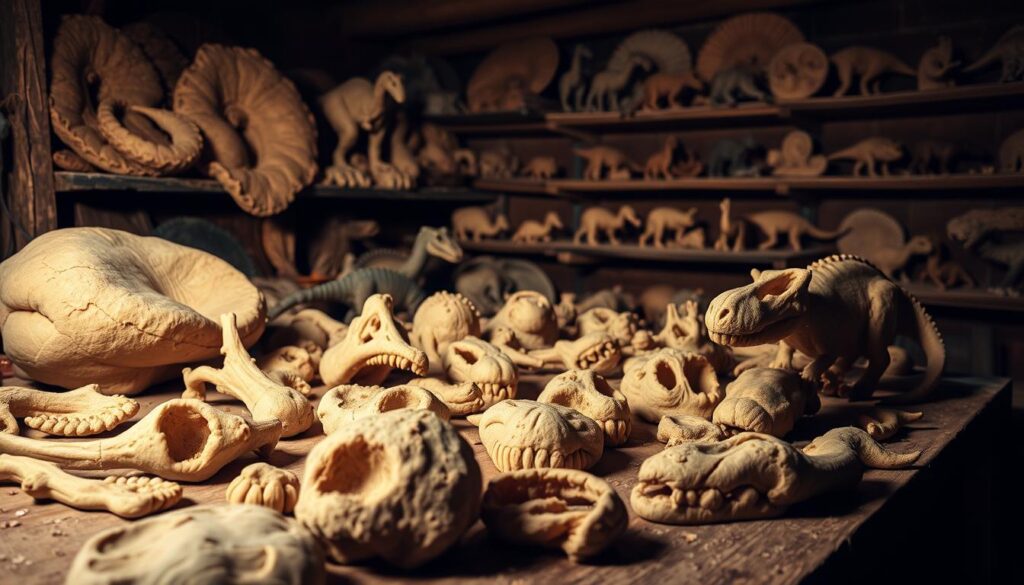
When 7-year-old Mia discovered her homemade “fossil” could survive a backyard dig, she declared: “I’m keeping this forever – it’s better than my glow-in-the-dark rocks!” This hands-on activity turns kitchen ingredients into ancient artifacts that spark scientific curiosity.
Salt Dough Recipe and Set-Up
Whip up your prehistoric putty with three simple ingredients. Combine 2 cups flour, 1 cup salt, and 1 cup warm water using a hand mixer. The dough should feel like stiff cookie batter – add flour if sticky. “Letting kids measure ingredients teaches fractions naturally,” notes educator Mark Torres.
| Material | Purpose | Pro Tip |
|---|---|---|
| Wheat flour | Creates smooth texture | Use for darker “mudstone” effects |
| Table salt | Preserves shape | Coarse salt adds realistic texture |
| Plastic dinosaurs | Impression tools | Choose varied foot shapes |
Creating Fossil Impressions
Flatten dough balls into pancake-thick discs. Press toy feet firmly for 10 seconds – lift slowly like real paleontologists. Bake at 250°F for 2 hours to harden. These durable creations become excavation treasures when buried in sand bins.
Watch young scientists:
- Compare herbivore vs carnivore footprints
- Measure impression depths with rulers
- Recreate fossilization timelines using egg timers
One parent shared: “Our fossil hunt lasted three afternoons – they even labeled finds with scientific names!” The magic happens when playtime becomes a gateway to earth science.
DIY Dinosaur Crafts with Everyday Items
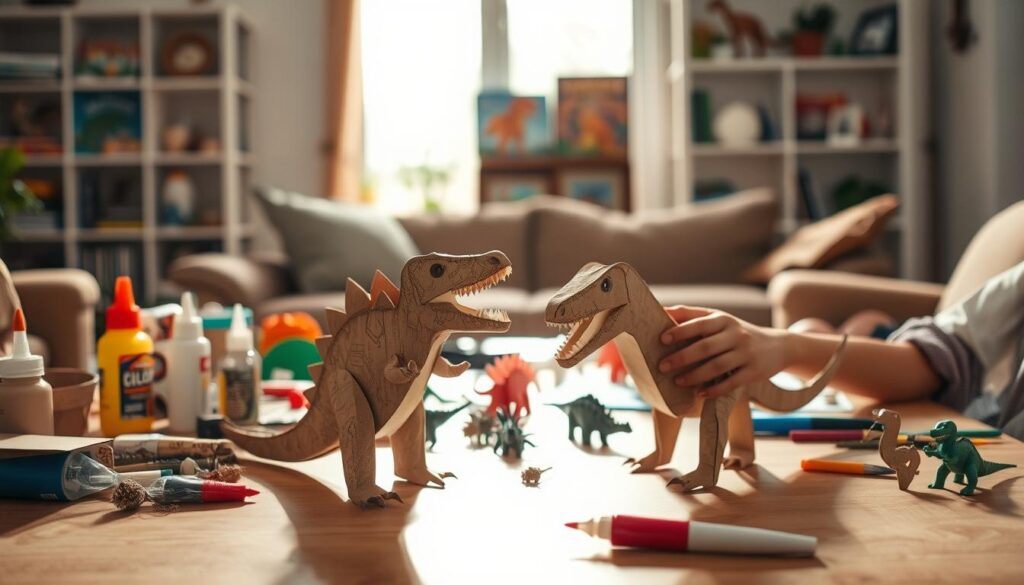
While cleaning out her pantry, second-grade teacher Mrs. Rodriguez found an unexpected art supply: empty oatmeal containers. “We turned them into armored ankylosaurs with clothespin legs,” she recalls. “The kids were arguing about spike placement – that’s biology in action!”
Transform ordinary objects into roaring masterpieces with these clever ideas:
| Material | Project Example | Learning Focus |
|---|---|---|
| Toilet paper rolls | 3D triceratops with foam horns | Spatial reasoning |
| Cupcake liners | Colorful stegosaurus spines | Pattern recognition |
| Mason jars | Miniature Jurassic ecosystems | Habitat studies |
Clothespins become walking legs when attached to painted tubes. Folded liners create textured scales when layered. “We used old coffee grounds to ‘age’ our jar scenes,” shares dad and weekend paleontologist Carlos Mendez. Pro tip: Let kids sort materials by texture before crafting – it builds observational skills.
Most projects take 30-45 minutes, making them ideal for after-school sessions. The real magic happens when children realize their snack packaging could become a pterodactyl’s wings. As one 8-year-old creator put it: “I’m not just making toys – I’m saving the planet one dino at a time!”
Ready to combine letters with prehistoric fun? The next section shows how ABCs meet T-Rex in educational play.
Dinosaur Crafts and Activities for Preschool Learning

Preschool teacher Ms. Alvarez noticed her students’ eyes lighting up when letter practice involved stomping triceratops cutouts. “They started shouting ‘D is for Dino!’ before I even finished setting up,” she shared. Combining early literacy with prehistoric play creates natural excitement for young explorers.
Alphabet Adventures with Prehistoric Flair
Transform letter recognition into tactile experiences. Scrunching green tissue paper for D-shaped collages builds finger strength while reinforcing phonics. One parent reported: “My son started spotting Ds everywhere – on signs, books, even his snack crackers!”
| Activity | Materials | Skills Developed |
|---|---|---|
| Letter D Collage | Tissue paper, glue, cardstock | Fine motor control, sound recognition |
| Bubble Letter Textures | Sand, rice, foam letters | Sensory integration, shape tracing |
| Counting Spikes | Orange paper triangles, number cards | Math fundamentals, pattern creation |
Add dimension with simple adaptations. Gluing triangular “spikes” along curved letters teaches counting through play. Googly eyes turn basic shapes into friendly creatures that kids proudly display.
These multi-sensory approaches help information stick. Children learn letter forms by feeling textured outlines while associating sounds with familiar creatures. As Ms. Alvarez notes: “Their retention skyrocketed when we linked letters to dinosaur traits they love.”
Step-by-Step Dinosaur Craft Projects for Kids
Watching a child’s eyes light up when their cardboard T-Rex takes shape never gets old. Structured projects with clear directions turn frustration into triumph, one step at a time. These activities build more than just cute decorations – they nurture problem-solving muscles through creative challenges.
Building Skills Through Guided Creation
Start with basic techniques like tracing hands for instant personalized reptiles. Layer masking tape on cardstock before painting to reveal surprise patterns. “The tape peeled off like magic!” giggled 5-year-old Elena during her resist art experiment.
Simple instructions help young makers focus on the process. Cutting zigzag spines from orange paper teaches precision. Gluing buttons as scales reinforces counting skills. One parent shared: “Our color-and-count book became his favorite bedtime story!”
These projects grow with children’s abilities. Early efforts might involve matching pre-cut shapes, while advanced builders assemble 3D scenes. Each completed step fuels confidence to tackle bigger challenges – both at the craft table and beyond.
FAQ
How can I combine creative projects with educational themes?
What household items work best for budget-friendly projects?
Are salt dough fossils messy to make?
Can preschoolers safely participate in these activities?
How do I make a paper plate stegosaurus?
What skills do these projects help develop?

Eduard Kingly is a travel and lifestyle content creator with a focus on personal development and education. He combines firsthand travel experiences with research-driven insights to guide readers in discovering new places, building better habits, and pursuing meaningful learning.

